Soldiering Up

Marlon Scott recalls stepping across the Syrian border as a marine and wondering, “What are Russian troops doing here?” Ultimately, that question sparked his interest in studying political science and international relations. (Photo: Thomas Sanders)
“Is it real?” a student asks, pointing to Marlon Scott’s desert camouflage backpack. “Do you mean the material? Of course, it’s real,” says Scott, a San José State political science major and former Marine Corps corporal. He knows what the student is actually asking. One of the many questions he frequently evades: Were you over there? What did you see? Are you crazy? After two deployments to Iraq with his infantry unit, Scott decided to get out of the military, go to school and get “back into the world.” Scott now carries his books around campus in a black Jansport backpack. He replaced his government-issued pack to avoid the questions and “serious eyes” he’d get when carrying around the one visible indicator that he’s a veteran.
Scott doesn’t mind talking about his four years as a marine, as long as he’s offering the information. The backpack drew attention to him—and sticking out too much can be uncomfortable for a veteran. Making the transition from military service to student life is often fraught with unique challenges and questions: What aspects of being a veteran serve a student well? What will take a minute-to-minute effort to suppress or leave behind? How will other students and professors feel about veterans? Who am I, now that I’m not in the military?
Adapting to college
In many ways universities are set up like the military. There’s acronym-laden jargon, a chain of command, with the university president at the top, and a bureaucracy that builds character. However, those similarities aren’t readily apparent to veterans. Navigating as a student at San José State without a clear understanding of the university’s structure can be confusing and frustrating.
“It’s a lot of feeling your way around in the dark,” says Scott, who transferred to San José State from De Anza College two years ago. Scott says that he tried, “a little bit out of pride,” to plot out his courses and manage on his own but quickly realized he needed a new strategy.
Hundreds of San José State students are veterans. While their personal backgrounds and military experiences vary widely, a large number of veterans share Scott’s challenges. Last year, San José State began offering Warriors at Home: Succeeding in College, Life and Relationships, a class to help veterans manage the transition to civilian life and college.
Anne Demers, ’00 MPH, assistant professor of health science, and Elena Klaw, professor of psychology, developed the course after conducting a related Blue Shield-sponsored study on veterans’ needs at universities. Demers became interested in working with veterans when her son returned from one of his many deployments to Iraq with the Army. For her doctoral dissertation, she had been researching how young people living on the streets were able to turn their lives around. She says in listening to the soldiers’ stories she noticed “a real crisis of identity.” The soldiers’ stories echoed the questions the young people in her doctoral study had: Who am I? Where do I belong? How do I fit in?
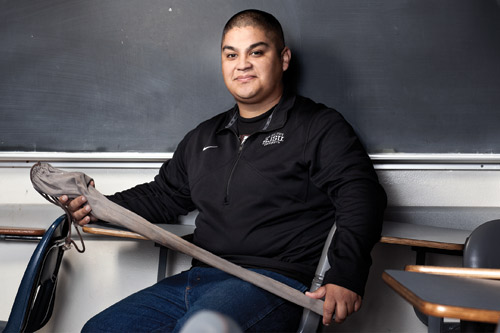
Ricardo Gonzalez says being at SJSU is like getting medals or other symbols that recognize military accomplishments—like his noncommissioned officer sword. “Man, you feel proud.” (Photo: Thomas Sanders)
“The vets have told me how difficult the transition to the civilian world is, how it’s a culture shock,” says Klaw, who is co-teaching this fall’s class. Among the students in the class is Ricardo Gonzalez, a social science major who sports a buzz cut—an efficient haircut he’s had since before his years as a heavy equipment operator in the Marine Corps. A proud husband and father of two, Gonzalez left the military as a corporal in 2007 and plans to be a middle school teacher because, he says, at that stage in school students either “become a statistic or decide to make something of themselves.” He volunteers at Stonegate Elementary, near the San José neighborhood where he grew up. “Learning about post-traumatic stress disorder (PTSD) and other issues is important for us and for faculty members—especially learning about how to see the signs, treat it and make it better,” says Gonzalez of the class. “A lot of these veterans who just got out don’t know what they’re feeling.”
On the other hand, “veterans’ experiences aren’t as simple as PTSD and traumatic brain injury (TBI),” says Klaw, who got some of her clinical training at the Department of Veterans Affairs (VA) in Palo Alto. Some veterans have been in combat and some have not. The way each veteran served can be very different, she says, so building community is neither simple nor easy.
Gonzalez, who was deployed twice to Iraq, says, “San José State has to find more ways to attract veterans.” In addition to the class, having a place for veterans to gather at San José State would really help, he says. For now, alongside a display case full of old helmets and other relics from bygone soldiers, there are a few cozy chairs in the Burdick Military History library in the Industrial Studies building—donated by retired Marine Corps Major General Anthony Jackson, ’71 BA, ’73 MA History, ’11 Honorary Doctorate of Humane Letters. At West Valley College, where Gonzalez graduated with a social science associate’s degree, veterans have their own study room. “That’s what started attracting a lot of people,” he says.
Identifying vets
Helping veterans get engaged on campus and making sure they are aware of the resources available to them is difficult because, Gonzalez says, “a lot of veterans have gotten out for a reason.” That means some veterans don’t want to talk about their service, preferring to just leave it behind. And some may struggle with the decision to even disclose their military service. Unless they join the Veterans Student Organization (VSO) or another student club, or take the Warriors at Home class, veterans tend to be on their own among the rest of the students.
Marlon Scott sticks to his “one-man show,” plotting out in his non-digital planner his wake-up time—reveille, as he and the Marine Corps call it—meals, transportation by bicycle and light rail and assignments to be completed—as if his orders were handed down to him from his commander. Scott may have put away his combat boots and uniforms, but the marine he was remains. He understands structure and what it means to have a mission. He doesn’t own a television. That would be too distracting. And Scott does not quite relate to the other students’ “Justin Bieber fever” or some of their behavior.
“My first impression in class was, ‘wow, I’m old,’” says Scott, who is 26 and doesn’t have a Facebook page. “It felt like I was back in high school, with students yelling, talking and using Facebook in class. I’m a big kid, but when you go into the military, you mature.”
Julie Kelemen, a public relations major and former Army specialist, says being a burn care nurse at the U.S. Army Research Institute in Texas had a real impact on her. “The extent of the injuries, the pain and suffering were worse than I thought,” she says, her voice getting quieter. “But the soldiers’ motivation and drive were inspiring. A lot of times they wanted to go back and they felt bad that they were in the hospital because they had left their units behind.”
Veterans clearly have very different lived experiences compared to the average San José State student. According to Elena Klaw, “a large proportion of vets are not getting help, not reaching out to the VA or connecting to resources or social services,” which was the impetus for creating the Warriors at Home class.
San José State continues to augment resources for veterans. Most recently, it was awarded a one-year U.S. Department of Defense grant, called the Veterans Integration to Academic Leadership (VITAL) initiative. Kelemen, who belongs to the VSO and College Republicans at SJSU, is doing outreach to woman veterans at the new VITAL office, where veterans can find support. However, she says getting woman vets involved on campus is really difficult. “I’ve even tried bribing them with free shampoo, shaving cream and other little things, but it hasn’t worked.”
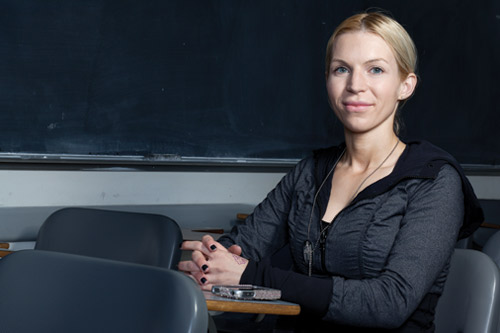
Julie Kelemen is majoring in public relations because her favorite part about being
an Army nurse was interviewing patients and writing patient histories. (Photo: Thomas Sanders)
Battling misconceptions
While Klaw and Demers are helping Kelemen reach out to woman vets, all veterans must manage one challenge individually: misinformation about the military. For example, when Kelemen tells other students that she’s a veteran, they’re usually stunned. Her soft voice and small stature belie her soldier’s training—but she quickly pulls out her bejeweled smartphone to share a photo of her green camouflage-painted face during a nighttime training drill at Ft. Bliss. And, Kelemen says, she’s quick to challenge those “who don’t like the military and have never been faced with a member of the military.”
A student once told Kelemen there’s no good reason to be fighting around the world. Kelemen calmly explained that the U.S. fights to defend the American way of life. From her experience in the burn care unit, Kelemen says, “I learned that we should appreciate the small things in life and our freedom—and the freedom to be oblivious to the bigger issues and events going on in the world.”
“Most people know almost nothing about the military or veterans,” says Demers. Only about one percent of the population has a family member in the service, she explains. That’s because it’s a volunteer military. But, she says, when veterans are open to sharing their experiences, they have a lot to contribute in class—and can help dispel myths about the military and veterans. “Having an open dialogue in a safe, respectful place is really powerful,” says Demers of a discussion that occurred in her class. Demers remembers a “profound” experience in her upper-division community mental health class last spring when two students, a veteran and an African refugee, shared their experiences in war-torn countries—and helped the class understand how they might treat traumatized communities.
“Nobody thinks about the supporting roles or humanitarian aspects of service,” Scott adds. “I don’t think anybody likes war. There’s a misconception that veterans and soldiers thrive on violence.”
Another common assumption is that all veterans suffer from PTSD. Vets are often asked: Do you have PTSD? Are you going to go crazy? Scott wonders: “How do I respond to that?”
Scott keeps a sense of humor about such questions and figuring out his path. “Going to college is a transition. It’s not like putting on a new pair of shoes,” he explains. “But if a veteran is in school, he or she means business.”
Jody Ulate is the editor of Washington Square. An Army veteran, she wore these highly shined boots when she was deployed in support of the peacekeeping mission in Kosovo, 1999–2000.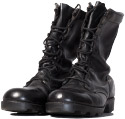


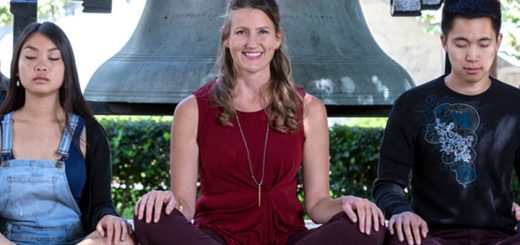
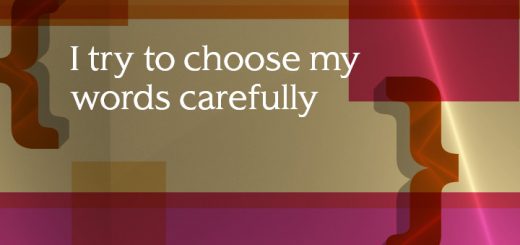
We’re thrilled that so much has changed since this story was originally published. We received the following note from a campus reader.
How wonderful to see a returning vet on SJSU’s homepage! I read the story and was surprised to see that it was published in 2012. So much has happened since then. An update seemed warranted.
For example, in the president’s opening address on August 19, he announced plans to hire a vet coordinator and to establish a Veterans Resource Center. (This is exactly what Ricardo Gonzalez recommended in your piece). Funding for the VITAL program was renewed for a second year. (And, by the way, this program is funded by the Department of Veteran Affairs, not the US Department of Defense). Furthermore, the VSO and Warriors at Home class are NOT the only resources for student vets. The VITAL program offers care coordination and counseling services on campus, as well as VA work study opportunities. The Veterans Advisory Committee is also active and includes faculty and staff members, administrators and students. The VAC and VITAL have worked together to distribute scholarships to student veterans and to provide trainings for faculty and staff.
Thanks for all the terrific updates! -Ed.